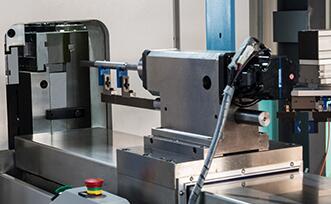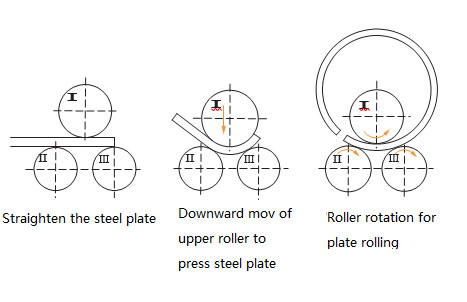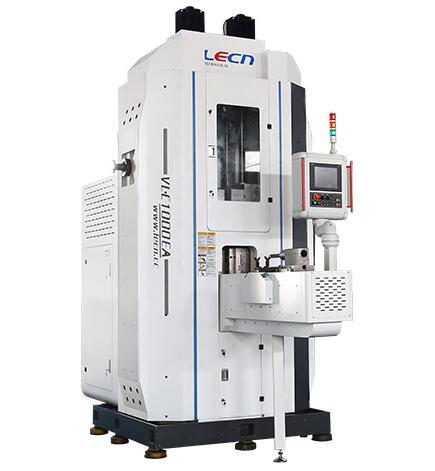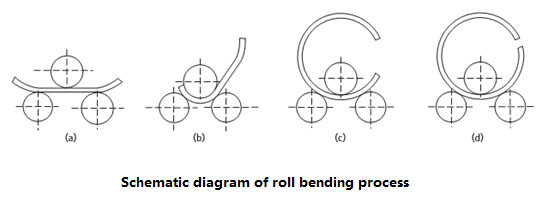Dec. 09, 2021
As modern manufacturing demands increasingly complex, precise, and efficient metal forming solutions, 3 Roll Bending Machines have emerged as essential tools across industries. Whether applied to automotive drive shafts, construction machinery, or industrial hardware, this highly versatile equipment streamlines the bending and forming of metal sheets and pipes into customized cylindrical or conical shapes.
With the rapid development of the manufacturing industry, offshore oil and gas, petrochemical, coal chemical, heavy high-pressure vessel products are becoming more and more popular, thousand-ton hydrogenation reactor, two thousand-ton coal liquefaction reactor is widely used, so that heavy rolling thick plate and high-strength plate of special rolls become key equipment. This article will introduce you the working principle and rolling process of 3 roll plate bending machine.
When it comes to shaping metal sheets or profiles, roller bending is a widely used technique that allows for the creation of curved parts with high precision and efficiency. A 3 roller bending machine, also known as a 3 roll bender, is particularly popular in various industries due to its versatility and capability to handle different materials and thicknesses. This type of roller bending machine can process both thin and thick metals, making it an essential tool for projects requiring roll bending sheet metal into cylindrical or arc shapes. The 3 roll bender stands out because of its ability to adjust the position of its rollers, which enables the operator to control the curvature of the final product, ensuring that it meets specific design requirements. Whether you're working on small-scale projects or large industrial applications, a 3 roller bending machine offers the flexibility and power needed to achieve professional results in roll bending sheet metal.
Working Principle of the 3 Roll Bending Machine
The working principle revolves around three primary rollers:
Top Roll (Upper Roll): Moves vertically to press the workpiece.
Lower Rolls (Bottom Rolls): Rotate and support the workpiece while controlling its movement.
Key operational steps:
Pre-Bending: The metal sheet is clamped between one lower roll and the top roll to reduce flat spots at the ends.
Rolling: The top roll descends while the bottom rolls rotate, gradually forming the material into a curve.
Final Adjustment: Additional passes may be made to achieve tighter radii or to produce conical sections.
Advanced models feature hydraulic systems and CNC controls, allowing for multi-radius bending and precise adjustments, improving efficiency and product consistency.
Rolling machine, also called rounding machine and roller machine, is a general forming equipment for rolling metal plates into cylindrical, conical and curved shapes.
According to the principle of three-point forming circle, the relative position change and rotational movement of working rollers make the metal sheet produce continuous plastic deformation, so as to obtain the workpiece of predetermined shape.
It is widely used in boiler, shipbuilding, petroleum, chemical, metal structure and machinery manufacturing industries.
As shown in the figure below, the three-roller plate rolling machine usually takes two lower rollers as the active rollers, which can realize forward and reverse rotation. One upper roller is the driven roller, which can move up and down vertically.

When rolling the sheet metal, the plate is placed between the upper and lower rollers, and the plate can be bent into an arc or closed circle through the three cutting points exposed on the sheet metal by the three rollers.
Therefore, the forming process of sheet metal can be regarded as a continuous three-point bending process performed by a three-roller bending machine.
In the process, one end of the sheet metal is fed into the three-roller plate between the upper and lower rollers, and then the upper rollers displace the sheet metal downward, causing a certain plastic bending deformation of the plate below it due to compression.
When the rollers rotate, there is friction between the plate and the rollers, so when the rollers rotate, the plate also moves along its longitudinal direction.
The lower roller alternates forward and reverse rotation, the roll plate moves back and forth, the two lower rollers rotate, and the friction drives the plate and the rollers to move.
At the same time, the upper roller continues to exert downward pressure on the roll, and the upper roller moves back and forth on the plate.
When the plate passes through the bottom of the upper roll in turn (roll deformation zone), the stress exceeds the yield limit, plastic deformation will occur, and the plate gets plastic bending deformation along its full length and is processed into the required shape.
Proper adjustment of the relative position of the upper and lower rollers, the plate can be bent to a radius not less than the radius of the upper rollers.
The following is the working principle diagram of the symmetrical three-roller plate rolling machine.

The driven rollers II and III are driven by motor and reducer and rotate in the same direction and at the same speed (or in the opposite direction).
Due to the friction between the roller and the plate, the plate is driven forward and the roller rotates.
Appropriate adjustment of the upper roller position can make rolls of different curvature plates.
If the workpiece cannot reach the required curvature after rolling processing, the upper roller can be lowered appropriately and then reverse rolling can be repeatedly performed until it is rolled into the required shape.
As can be seen from the above diagram, the three rolls of the symmetrical three-roller bending machine are arranged in an isosceles triangle, so the two ends of the workpiece are bound to leave a straight line during the rolling process.
The length of the straight segment is about half of the distance between the centers of the two lower rollers. This part of the straight line is where the rollers cannot roll, which is the biggest drawback of symmetrical three-roller rollers.
Despite the disadvantages of the symmetrical three-roller rolling machine, but because of its simple structure, easy operation, low cost and widely used.

The material must be confirmed in accordance with the drawings and process requirements, and the surface of the material should not have obvious defects. Material quality and specifications should comply with relevant national standards and industry standards.
When expanding, the barrel diameter must be the same as the actual diameter of the end shell, and the barrel material diameter should be calculated according to the middle diameter of the barrel.
The direction of the unfolded length should be the same as that of the rolled steel, and the limit position is 45°.
The alignment should be reasonable, making full use of the edge material and improving the utilization rate of steel.
When welding multiple sections of the cylinder, the welding seam should be properly configured according to the technical requirements of the equipment assembly welding.
End shell butt welds, cylindrical shell section longitudinal weld arc distance between the weld edges should be greater than three times the thickness of the cylinder and not less than 100mm.
When the cylinder is connected to the tube, bracket, reinforcing ring, bottom plate, etc., the insertion relationship of the longitudinal and circumferential welds on the cylinder should avoid the weld opening or too close to the reinforcing ring or bottom plate to cover the weld. Weld seam.
Drawing lines should be accurate, and a vertical line, bisector and bisector should be drawn using geometric mapping, not a square bus.
Leave the necessary margins and draw edge cut lines on the sheet metal first, then draw an actual material line and check the line.
The line drawing tolerance requirement for the height H of the cylinder is: H±1mm
The difference between the two diagonals △ L = L1 - L2 ≤ 2mm, the tolerance of the length of the cylindrical section L ± 3mm
Perimeter formula: L = π (Di + S), where Di is the diameter of the cylinder (mm), S is the thickness of the cylinder (mm).
After marking, make material marking transplant in the square of 100mm×100mm in the upper right corner of the steel plate.
Carbon steel plate thickness <12mm, try to use shearing machine for undercutting (otherwise use semi-automatic shearing), clear slag and deburring after shearing.
When slotting is required, semi-automatic cutting machine or rolling chamfering machine is used when the plate thickness >6mm.
When the plate thickness is less than 6mm, grinding method is appropriate.
The bevel produced by flame cutting machine should be cleaned off the slag, and the welded bevel should not have defects such as cracks and delamination. The surface of the welded joint should be cleared of oxides, grease, slag and other harmful impurities before welding.
Gap range (calculated from the edge of the slot or plate) ≥ 20mm.
Plate in the rolling, each end of the plate has a length of bendable due to non-contact with the upper roll, known as the residual straight edge.
Symmetrical bending, the remaining straight edge is usually about half of the center distance of the lower roll, also related to the plate thickness.
Asymmetric bending residual straight edge is about 1/6 to 1/10 of the symmetric bending.
This part of the remaining straight edge is difficult to completely eliminate during calibration, and is prone to quality and equipment accidents, and should be pre-bent.
If there is no pre-bending, you can use a template for calibration after the final roll.
The surface of the steel plate must be cleaned before bending, and the roll surface must not have rusty skin, hair, edges, or hard particles.
For example, when rolling stainless steel, the upper and lower rolls must be wrapped with a special layer of tape or paint, and the protective layer must not have hard particles.
When the plate is put into the rolling machine, in order to prevent skew, the workpiece should be twisted and the main line of the workpiece should be parallel to the roller axis to ensure the quality of round rolling.
Rolling circle
Rolling circle is the main process of product forming, which is divided into one-feed and multi-feed process.
The number of feeds depends on the process (such as cold rolls are not allowed to exceed the maximum deformation rate allowed) and equipment limitations (such as anti-slip conditions and power conditions).
When the cold roll rebound is large, a certain amount of re-rolling must be added.
The longitudinal misalignment of the barrel end requires less than 1.5 mm.
The rolling process of the plate is shown in the figure below.

The purpose of roundness correction is to make the curvature of the whole circle as uniform as possible in order to improve product quality.
In general, the steps are as follows.
(1) Feeding
Based on experience or calculation, the rollers can be adjusted to the maximum correct curvature position.
(2) Round rolling
Roll the cylinder two times under the correct curvature, focusing on rolling the welding position so that the curvature of the whole circle is consistent.
(3) Unloading
Gradually reduce the load so that the workpiece can be rolled up several times under the reduced corrective load.
If you want to know more information about 3 roll bending machine, please contact us. We will provide professional answers.
Previous: None
Next: None